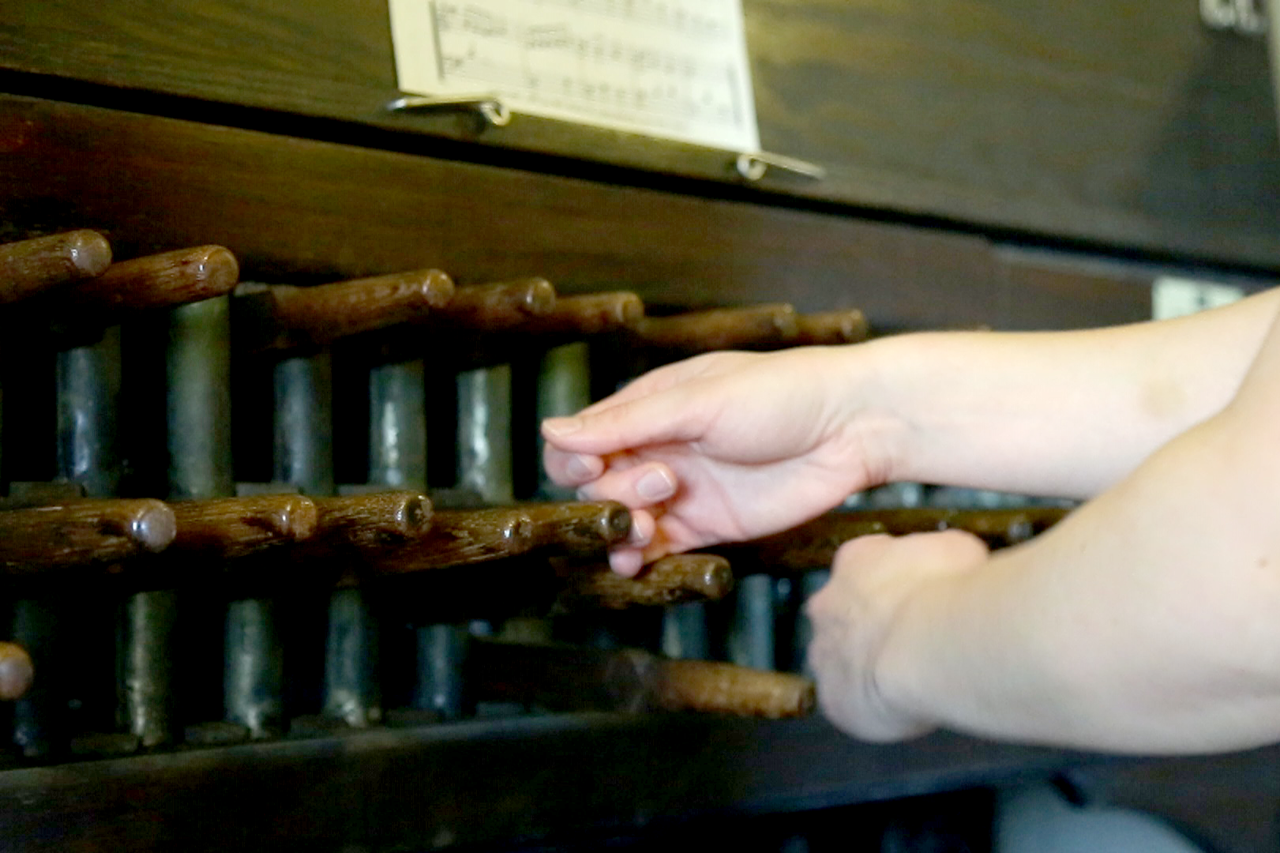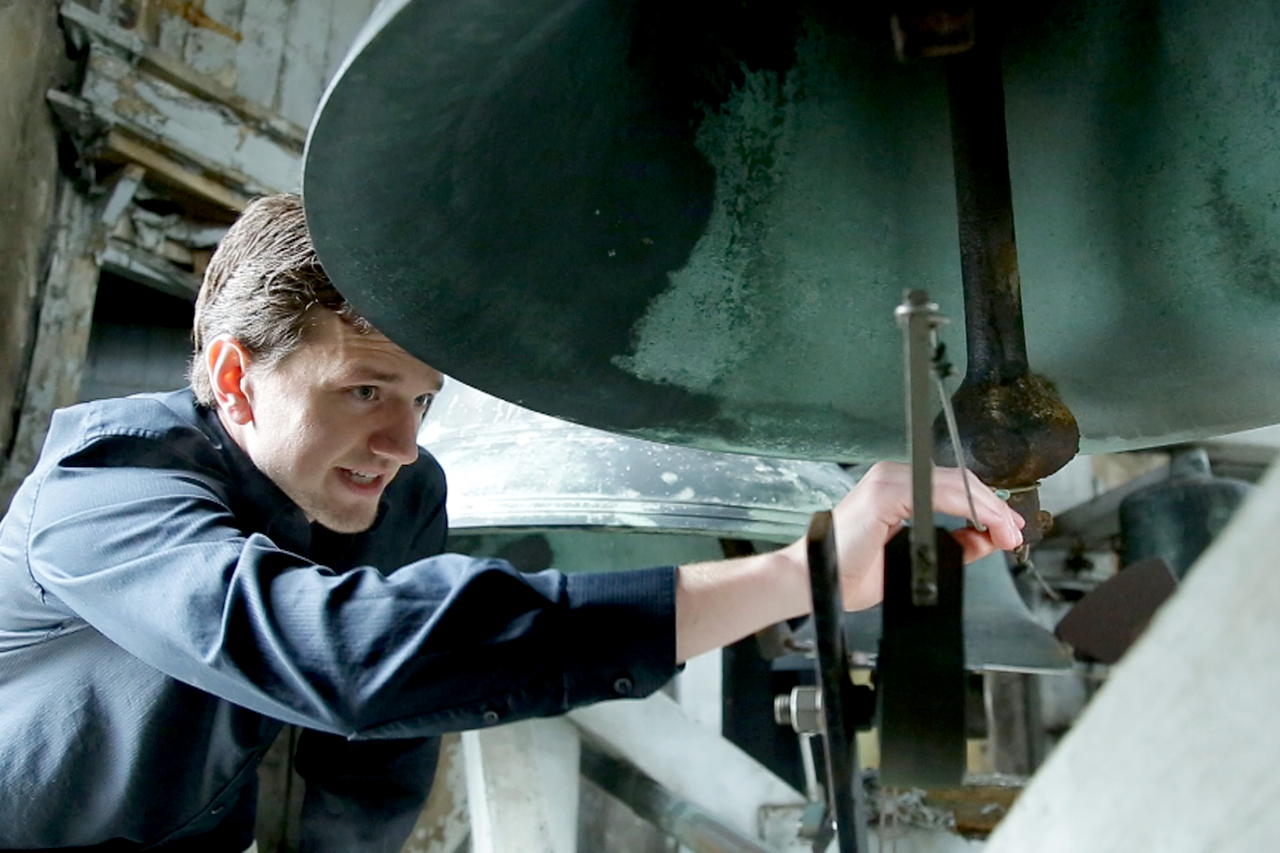Chicago's bells
Reported by Steven Jackson
At Christ the Savior, parishioners don’t sit in pews; they stand for the entire service in the nave. During the past decade, the entire church has undergone major renovations. The effort was spearheaded by priest and rector Father John Baker, who was a carpenter before he joined the church. (Photo by Steven Jackson)
Choir Director Philip Sokolov and Father John Baker in the bell tower. Their church would never automate their bells; zvon performances are sacred and must be conducted by a designated person who is blessed by the priest. (Photo by Steven Jackson)
The zvon is rung before Saturday evening vigil and Sunday morning service, as well as on special occasions. Before Christ the Savior purchased these bells in 2006, the congregation made its own by cutting the bottoms off of steel welding tanks and striking them with ball peen hammers. (Photo by Steven Jackson)
The trezvon (triple-peal) is the most up-tempo and joyous zvon technique. The trezvon is normally rung for the length of time it takes to read Psalm 50. (Photo by Steven Jackson)
The liturgical art of zvon has a long, embattled history. First, the Ottoman Empire in the 15th century outlawed Orthodox bell ringing in their territory. More recently, under the Soviet Union, countless bells — and entire churches — were destroyed, and bell production all but ceased. Only since the fall of the Iron Curtain have Russian bell foundries resumed production. (Photo by Steven Jackson)
Mitchell Tower is home to the University of Chicago Guild of Change Ringers. The bell tower was built in 1908, modeled after Oxford’s Magdalen Tower. (Photo by Jesse Dukes)
Mitchell Tower has 10 bells in all, ranging in weight from about 500 lbs to over 2 tons. They were dedicated in 1908 to Alice Freeman Palmer, the University of Chicago’s first Dean of Women. Each bell is inscribed with one of Palmer’s qualities — things like “Fervent in spirit” and “The sweetness of her lips increasing learning.” (Photo by Steven Jackson)
The Guild is a mix of students and folks from Hyde Park, led by volunteer Tom Farthing. Most of the ringers are amateurs. Some are drawn to it for the mathematical thinking it demands; others say it’s the ideal social activity for introverts. (Photo by Steven Jackson)
A cloth covers the clapper, keeping the bell silent, as well as keeping neighbors happy. These bells have a long history of noise complaints. After a lengthy bout of ringing in 1910, the university president received an angry letter: “If I were a self-respecting student I should proceed at once to organize an expedition to drag [the bells] down from the belfry the next dark night ... to the bottom of Lake Michigan.” (Photo by Steven Jackson)
Kent Oliven (right) inspired Curious City’s investigation into live bell-playing in the Chicago area. Kent, bell enthusiast that he is, posed many questions to Kimberly Schafer, a Chicago-area bell expert and a self-described bell advocate. (Photo by John Fecile)
Carillons originated in the Low Countries (now Netherlands and Belgium) in the Middle Ages, then spread to North America in the 20th century. St. Chrysostom’s carillon was installed in 1927, making it the second of the instruments in the Midwest (the first was in Detroit). The bells were cast by the English bell foundry, Gillett & Johnston. (Source: Wikimedia Commons)
The kansho, or “calling bell,” is rung before every service to summon members to the temple hall, or hondo. The kansho’s first recorded use in Shin Buddhist temples was in the 17th century.
The kansho is traditionally rung in three sets of 7, 5, and 3 strikes. Between each set, a series of fast, soft beats crescendo to slow, loud beats — then decrescendo back again. The numbers 7, 5, and 3 are pivotal numbers in Japanese Buddhist culture, with such ancient origin that their exact meaning has been lost. (Pictured here is Darryl Shishito.) (Photo by Steven Jackson)
Music Ministries Associate David Plank plays the chime for special occasions and holidays, as well as community events such as Evanston’s Bike the Ridge ride. (Last year, he played Queen’s “Bicycle Race” during the event.) Plank is too busy to play the chime every Sunday; he also plays the organ and directs the choir. (Photo by John Fecile)
St. Mark’s has a mix of manual and automatic bell technology. Every 15 minutes, this clock-like chiming mechanism activates the clappers up in the bell tower to ring the Westminster Changes. This mechanism was installed in 1901, along with the bells and the chime-stand. (Video by John Fecile)
The largest bell has a Latin inscription. Translated: For the greater glory of God/To the church and parish of St. Mark’s/a friend gave me, along with eight other bells/out of a grateful heart/in the month of September, 1901/during the rectorship of the Rev. Arthur W. Little, L.H.D./I resound with the praise of the Lord; I summon the people to the gates of heaven. (Photo by John Fecile)
About this project
 This WBEZ Curious City answer was inspired by a question from Kent Oliven, Finance Director and Treasurer for the Village of Alsip, Illinois. And for some reason, bells have been a resounding theme throughout much of his life.
This WBEZ Curious City answer was inspired by a question from Kent Oliven, Finance Director and Treasurer for the Village of Alsip, Illinois. And for some reason, bells have been a resounding theme throughout much of his life. It started when he lived in England as a boy and toured the country's soaring cathedrals and bell towers. As a teenager, he was moved by the novel A Bell for Adano, about a village whose church bell is melted down by Mussolini during WWII. And for all the years Oliven has lived in Chicago, he's always noticed his neighborhood church bells.
Recently, Kent and his wife Kelly were sitting out on the back porch of their Palos Park home, when the sound of church bells wafted over on the wind. "My wife said it was beautiful, and I suspected it was pre-recorded." That experience started Oliven wondering about church bells and the people who play them.
Reporting by Steven Jackson | Art direction by Logan Jaffe | Production by John Fecile, Jesse Dukes and Shawn Allee | Development and production by Chris Hagan
More fun bell-playing by Kimberly Schafer and David Plank:
Special thanks to musicians Stephen Schwartz and Jeremy Schmetterer for notating Chance the Rapper's “Sunday Candy” for playing on the carillon.
Don't miss the audio version of this story below, or listen to it on our podcast:
More information on bells and bell-playing in the Chicago area and beyond:
Carl Zimmerman runs an alarmingly thorough bell tower database: www.towerbells.org.
Kimberly Schafer's blog, Bell Advocate, is a compendium of all things “bell.”




